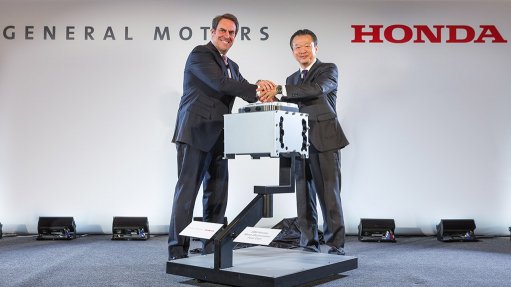
JOINING HANDS Honda’s Toshiaki Mikoshiba and GM’s Mark Reuss showcase their jointly developed next generation fuel cell stack system
US multinational corporation General Motors (GM) and Japanese multinational corporation Honda last week announced the establishment of the automotive industry’s first manufacturing joint venture (JV) to mass- produce an advanced hydrogen fuel cell system that will be used in future products from each company.
The JV will be named Fuel Cell System Manufacturing (FCSM) and will operate within GM’s existing battery pack manufacturing facility site in Brownstown, Michigan, in the US.
Mass production of fuel cell systems is expected to begin around 2020 and create nearly 100 new jobs. The companies are making equal investments totalling $85-million in the JV.
Honda and GM have been working together through a master collaboration agreement announced in July 2013. It established the co-development arrangement for a next-generation fuel cell system and hydrogen storage technologies. The companies integrated their development teams and shared hydrogen fuel cell intellectual property to create a more affordable commercial solution for fuel cell and hydrogen storage systems.
“Over the past three years, engineers from Honda and GM have been working as one team, with each company providing know-how from its unique expertise to create a compact and low-cost next-generation fuel cell system,” says Honda Motor North American region COO Toshiaki Mikoshiba.
Mikoshiba, who is also Honda America and Honda North America president and CEO, adds that the teamwork will eventually result in joint mass production of a fuel cell system that will help both companies create new value for their customers in fuel cell vehicles of the future.
FCSM will be operated by a board of directors consisting of three executives from each company that will include a rotating chairperson. In addition, a president’s position will be created, with incumbency alternating between the JV partners.
GM and Honda are “acknowledged leaders” in fuel cell technology with more than 2 220 patents between them, according to the Clean Energy Patent Growth Index. GM and Honda rank number one and number three respectively, in total fuel cell patents filed from 2002 to 2015.
“The combination of two leaders in fuel cell innovation is an exciting development in bringing fuel cells closer to the mainstream of propulsion applications,” states GM global product development, purchasing and supply chain executive VP Mark Reuss.
He says that the eventual deployment of this technology in passenger vehicles will create more differentiated and environment-friendly transportation options for consumers.
Reuss points out that fuel cell technology addresses many of the current major challenges facing automobiles, such as petroleum dependence, emissions, efficiency, range and refuelling times.
He highlights that fuel cell vehicles can operate on hydrogen made from renewable sources, such as wind and biomass. “Water vapour is the only emission from fuel cell vehicles,” Reuss notes.
Broadening Collaboration
In addition to advancing the performance of the fuel cell system, GM and Honda are working together to reduce the cost of development and manufacturing through economies of scale and common sourcing. The two companies also continue to work with governments and other stakeholders to further advance refuelling infrastructure, which is critically important for the long-term viability and consumer acceptance of fuel cell vehicles.
GM is currently demonstrating the capability of fuel cells across a range of land, sea and air applications. The company says that it has already accumulated millions of miles of real-world driving in fuel cell vehicles. GM global fuel cell business executive director Charlie Freese comments that, with the next-generation fuel cell system, GM and Honda are making a “dramatic” step toward lower-cost, higher-volume fuel cell systems.
He says that precious metals have been “reduced dramatically” and a fully cross-functional team is developing advanced manufacturing processes simultaneously with advances in the design. Freese states that this has resulted in a lower-cost system that is a fraction of the size and mass.
Fuel-Cell-Powered Vehicles
Honda began delivery of its new Clarity fuel cell vehicle to US customers in December 2016, following a spring 2016 launch in Japan. The Clarity was rated as having the best driving range by the US Environmental Protection Agency, of any electric vehicle without a combustion engine with a range rating of 366 mi and a fuel economy rating of 68 mi/gal of petrol- equivalent combined.
Honda Motor automotive operations director and chief operating officer Takashi Sekiguchi adds that the collaboration between the companies is an opportunity to further leverage the strengths of each company to popularise fuel cell vehicles at the earliest possible time.